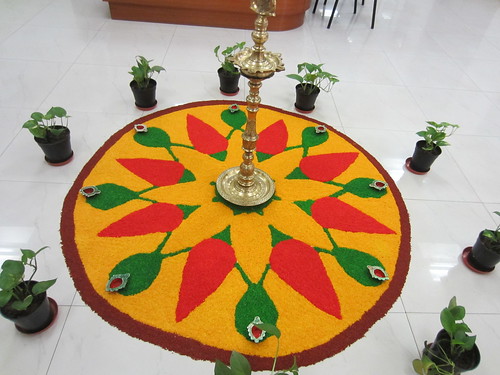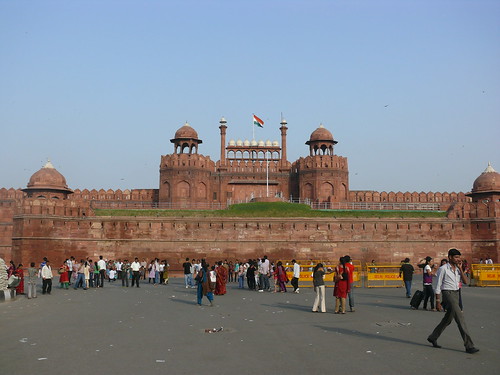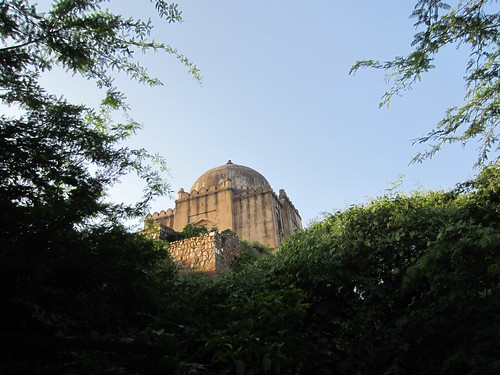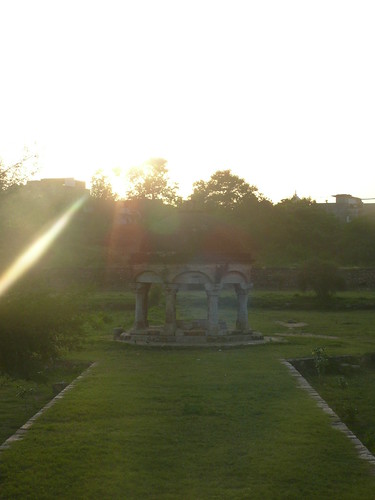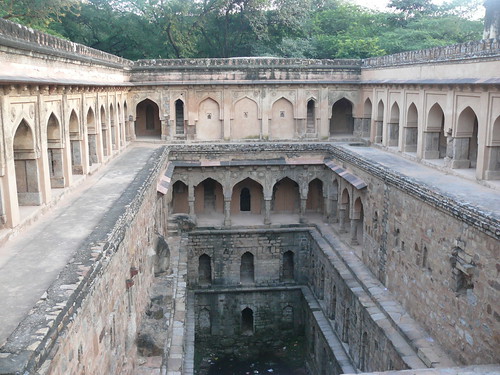The season of Diwali is alive and well in Delhi, and I feel as if I'm getting a bit of a Christmas season without it being Christmas. There was a large celebration at school, with the field lit up with more lights then I thought they could hang, an Indian dance performance, two guys wandering around on stilts who scarily would pick up little kids and dangle them above their parents, a chance to get a bit of henna done, and of course a good meal with friends. Then there are the decorations that have popped up in unexpected places. School is all dressed up for the holiday, even though we're actually going to be gone next week when Diwali occurs, with some more of the colored rice patterns which continue to amaze me and a multitude of golden clay lanterns and some small figurines of Hindi gods. There are even some melas going on that vaguely remind me of the Christmas markets in Prague and Germany. Vaguely....after all it isn't cold, and there is a whole different set of crafts (and cheap junk) that is available here. I even got to exchange a small gift with my maid who seems happy that I'm leaving so that she'll get the whole week off. It is a holiday season and I'm happy to take whatever type of celebration I can get...hopefully we'll get to experience a bit more of the lights that are supposed to accompany this holiday in Goa.
Sunday, October 23, 2011
Sunday, October 16, 2011
Delhi's Red Fort
Last weekend a friend and I headed into old Delhi to explore a bit. Our goal was the Red Fort (built in 1648), a name which clearly comes from the red walls that stretch 1.5 miles around nearly 125 acres of land. After a reminder that I should always carry my foreign registration card (the difference between a 10 rupee entry fee and 250 rupees) we streamed into the fort along with the crowds of Indians. I do appreciate that the tourism and heritage groups in India have kept the entry fees so reasonable priced that the locals can also enjoy the preserved heritage (even if it does make for larger crowds). We had to walk by a sandbagged guard (ummm...really, he'd just open fire?) and go through the woman's line to get patted down and our bags looked at, but then the peacefulness of the open architecture started to soak in. We spotted the Diwan-i-Aam, a pavilion where the emperor used to hold his public audiences, and figured that we should head in the direction. Most of the Indians were trying to capture a photo of the raised platform with ornate inlay where the emperor would have sat; I of course, was more interested in the arches holding up the pavilion. From there we wandered around the grounds, generally heading to less populated areas as we could see them, but making sure we looked at everything on the grounds: the private apartments of Mughal Emperor Shah Jahan topped by the scales of justice and with exquisite inlay (and more arches of course!), several side pavilions in white marble which screamed of tranquility, the Burj-i-Shamali a marble pavilion with a water chute which enabled residents to raise water from the Yamuna River below, the Moti Masjid, the Hayat Bakhsh Bagh which is a pleasure palace in the middle of a [dry] pool, and of course the out of place block barracks the British erected after the 1857 uprising. One lesson I did arrive at while wandering around and admiring the grounds and walls was that as I like taking pictures of people when I travel I can't really complain when others take pictures of me as we walk around. A lesson I'm sure I'm going to struggle to accept, but must if I'm not willing to give up the pictures I enjoy capturing the most.
For those of you who didn't realize it, the colored words in my posts are links which will take you to appropriate photos....
For those of you who didn't realize it, the colored words in my posts are links which will take you to appropriate photos....
Sunday, October 9, 2011
Dussehra Holiday
I looked out our office window last Monday to see this giant statue had been erected on the elementary field and maintenance workers were hosing down the field with water. Huh? Asking around a bit I gathered it had something to do with the holiday which was approaching on Thursday, Dussehra. I figured the watering of the ground meant somehow fire was going to be involved, but I was still a bit surprised when during second period I heard some fireworks going on, giving me just enough warning to look out my classroom window and see the statue being enveloped in fire. Okay...clearly I need to do a little research on this holiday if I'm going to understand anything!
Turns out that Dussehra is the end of a 10 day holiday which culminates in a celebration of good triumphing over evil. More specifically, celebrating the victory of Rama (the 7th incarnation of Vishnu) who killed the demon Ravana who had abducted his wife. Of course it required some secret knowledge and the blessing of Durga for Rama to succeed (it also considered a celebration of the Goddess Durga's victory over the buffalo demon Mahishasura). During the previous nine days numerous reenactments of Rama's life are performed and on the final day (Dussehra) the victory over evil is symbolized by the burning of the effigy of Ravana (sometimes along with his son and brother) and people are encouraged to similarly burn the evil within themselves and turn to follow a path of truth and goodness.
I still feel like I'm missing a good portion of what this holiday is really about, and perhaps next year I'll manage to see a bit more than at school, or the random trucks of costumed individuals driving by. In the mean time at least I now know that the Diwali festival of lights which is coming up is also tied to this as the celebration of Rama's return to his home after this victory. I have a feeling there is plenty more for me to figure out though.
Location:
New Delhi, Delhi, India
Tuesday, October 4, 2011
Mehrauli Archaeological Park
Finally. Finally I am starting to go our and see a bit of Delhi. Or at least I've made a start. I'm not sure I can say I'm finally starting if I don't see anything new in the next few weeks, but at least I've succeeded once. Saturday afternoon I joined a group of friends from school to go on a walking tour with Surekha who runs monthly walks around different areas of the city. This month was in the area surrounding the Qutb Minar, a 72 meter tall minaret built between 1211 and 1236. To the south is Mehrauli Archaeological Park, a lush oasis in the middle of the city filled with remnants of building from the Mughal empire.
However, that is not where we started. On the walk towards the park we took a slight detour to climb up to Azim Khan's Tomb. The renovation has just recently been finished and while there is some debate as to if it is the tomb of a general or the son of one of (Mughal Emperor) Akbar's wet nurses it is a pretty little place amid a block of green that provides nice views of the city...and a giant Buddha statue across the way.
Back down to the street we went to head to Mehrauli. I was constantly amazed that we didn't have to get very far away from the busy Delhi streets to end up surrounded in a quiet green growth. We walked over to what had, at one time, been quite a little estate. Across the bridge spanning a canal, then on to look at the boat house which now just overlooked a cluster of plants. Turn around to find a steep series of steps leading up to what is sometimes called Metcalfe's Folly. Originally it was the tomb of Mohammad Quli Khan (brother to one of Akbar's foster brother). In the early 1800s Sir Thomas Theophilus Metcalfe, British resident at the Mughal Court, decided to convert it into his summer residence. Yes, the tomb itself was turned into the dining room of his house with some wings added on to finish it up.
From there we went on to what was probably my favorite sight, the Rajon ki Bain boali or step well. A four level well built in 1506, which provided access to water at every level step wells often gathered small communities around their edges in the covered wings. We then continued to wind our way through the park as the sun started to set. Taking quick glimpses at small ruins along the way, including Balban's tomb dating back to the 13th century (Slave dynasty ruler of Delhi Sutanate), a pavillion with scrafitti on the ceiling (a term I had never heard before but referring to some kind of scratched in artwork), and a crumbling tomb of a Sufi saint that has been forgotten.
The final stop on tour was the Jamali Kamali tomb. Our guide wanted to save the best for last, unfortunately that meant we arrived after dark and my best view of the tomb came when I was looking at my pictures on the computer the next day. It really was unfortunate as our guide actually had to get someone to unlock the tomb so that we could see inside. This tomb containing Jamali (Sufi Saint and poet Shaikh Fazlu’llah) and Kamali (an unknown male companion) dates from around 1535 and has recently been renovated by the Archaeological Society. It is locked up in fear of people coming in and defacing the painted ceiling, ornate decorations or marble mihrab.
By the time we finished there it was dark and we carefully picked our way back to the street to jump in a rickshaw to head to dinner. I'm glad I took a few hours out of my day to get out and see a little bit of the history that Delhi holds. Now the question is, what next?
However, that is not where we started. On the walk towards the park we took a slight detour to climb up to Azim Khan's Tomb. The renovation has just recently been finished and while there is some debate as to if it is the tomb of a general or the son of one of (Mughal Emperor) Akbar's wet nurses it is a pretty little place amid a block of green that provides nice views of the city...and a giant Buddha statue across the way.
Back down to the street we went to head to Mehrauli. I was constantly amazed that we didn't have to get very far away from the busy Delhi streets to end up surrounded in a quiet green growth. We walked over to what had, at one time, been quite a little estate. Across the bridge spanning a canal, then on to look at the boat house which now just overlooked a cluster of plants. Turn around to find a steep series of steps leading up to what is sometimes called Metcalfe's Folly. Originally it was the tomb of Mohammad Quli Khan (brother to one of Akbar's foster brother). In the early 1800s Sir Thomas Theophilus Metcalfe, British resident at the Mughal Court, decided to convert it into his summer residence. Yes, the tomb itself was turned into the dining room of his house with some wings added on to finish it up.
From there we went on to what was probably my favorite sight, the Rajon ki Bain boali or step well. A four level well built in 1506, which provided access to water at every level step wells often gathered small communities around their edges in the covered wings. We then continued to wind our way through the park as the sun started to set. Taking quick glimpses at small ruins along the way, including Balban's tomb dating back to the 13th century (Slave dynasty ruler of Delhi Sutanate), a pavillion with scrafitti on the ceiling (a term I had never heard before but referring to some kind of scratched in artwork), and a crumbling tomb of a Sufi saint that has been forgotten.
The final stop on tour was the Jamali Kamali tomb. Our guide wanted to save the best for last, unfortunately that meant we arrived after dark and my best view of the tomb came when I was looking at my pictures on the computer the next day. It really was unfortunate as our guide actually had to get someone to unlock the tomb so that we could see inside. This tomb containing Jamali (Sufi Saint and poet Shaikh Fazlu’llah) and Kamali (an unknown male companion) dates from around 1535 and has recently been renovated by the Archaeological Society. It is locked up in fear of people coming in and defacing the painted ceiling, ornate decorations or marble mihrab.
By the time we finished there it was dark and we carefully picked our way back to the street to jump in a rickshaw to head to dinner. I'm glad I took a few hours out of my day to get out and see a little bit of the history that Delhi holds. Now the question is, what next?
Subscribe to:
Posts (Atom)
